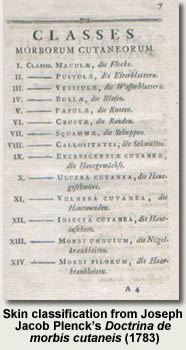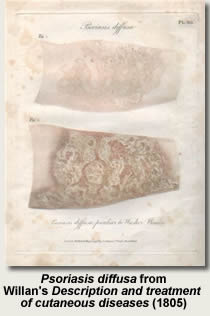Written by: Ron Sims, MA, Special Collections Librarian
The recorded dawn of dermatology can be traced to the Ebers Papyrus, a work of the Ancient Egyptians, which dates to the 16th century B.C. The papyrus is a miscellaneous collection of extracts and scraps of medical information from at least forty sources and was found in a tomb in Thebes in 1862. The ancient manuscript describes many kinds of skin diseases, cosmetic problems, and therapies. The Galter Library has one German and two English translations of the Ebers Papyrus.
Among the printed materials in the Library’s Special Collections are a number of landmark texts, which include: De morbis cutaneis (1572) by Girolamo Mercuriale; Jean Liebault’s Trois livres de l’embellissement et ornement du corps humai (1595); Daniel Turner’s A Treatise on Diseases incident to the Skin (1714); Tractatus de morbis cutaneis (1777) by Anne-Charles Lorry; Joseph Jacob Plenck’s Doctrina de morbis cutaneis, ed. 2. (1783); and, Description and treatment of cutaneous diseases, issued in four parts from 1798-1808 by Robert Willan.
Though better known for his De Arte Gymnastica (1569), Mercuriale’s De morbis cutaneis (1572) is a compilation of Greek and Roman philosophical ideas on the causes and cures for various skin conditions. This work is based on his lectures in Padua, where he was chair of practical medicine.
Liébault’s treatise on the beauty of the human body (Trois livres) describes cosmetic as well as practical advice for the preservation and restoration of skin. Remedies run the gamut of folklore as well as reasonable approaches to keeping the skin healthy.
Daniel Turner’s Treatise provided one of the first classifications of skin conditions. His anatomical and clinical observations were accurate, providing a good summary of the state of knowledge at the time. He is considered the father of British dermatology.
Across the Channel, the French father of dermatology, Anne-Charles Lorry provided a more thorough classification of diseases on the basis of essential relations, their physiological, pathological and etiological similarities. In Tractatus de morbis cutaneis, a scholarly and impressive volume at more than 700 pages, he described the skin as a living organ, noting the interactions with other organs. This contrasted with the previous view that skin was merely an enclosure for the body.
Plenck’s “Teachings on the diseases of the skin,” (Doctrina de morbis cutaneis) established him as the originator of the modern classification of skin diseases and the first to develop a practical system of terminology (1776). His classification is based on the morphology of the dominant lesion, naming 115 skin diseases, dividing them into 14 categories.
Robert Willan’s text (Description and treatment of cutaneous diseases) provides another classification of cutaneous diseases based on the morphology of the lesions. He had read Plenck’s text and further developed dermatological nomenclature.
These and additional treasures from the Library’s Special Collections will be on exhibit in the Eckenhoff Reference Room beginning the second week of October 2007.
Updated: March 5, 2020


